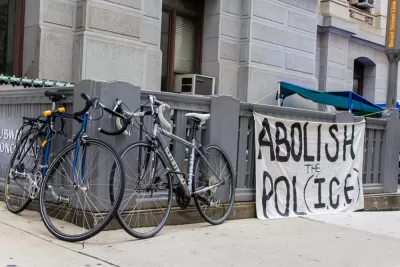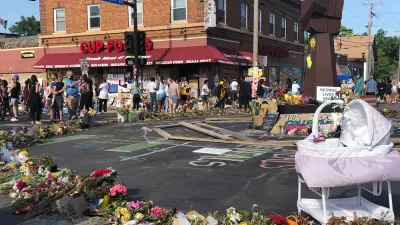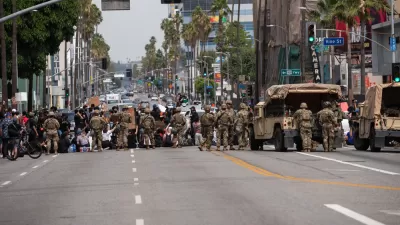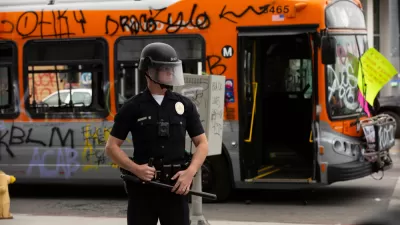It's no geographic accident that so many of the images emerging from nationwide protests have featured numerous protestors on bikes. These forces have been coalescing for years.

Recent images of New York Police Department officers focusing brutal tactics on people on bikes during protests in New York are in keeping with a long history of "hostility to cyclists, especially cyclists who are also left-leaning activists," according to an article by Jody Rosen.
And the cyclist-police nexus of conflict hasn't been unique to New York in recent weeks. "Bicycles have played a starring role in the nationwide uprising that has followed George Floyd’s death at the hands of Minneapolis police officers two weeks ago," writes Rosen. "In Los Angeles, San Francisco, Portland, Chicago, Atlanta, Miami, and dozens of other cities, protesters have pedalled and marched with their bicycles, facing off with police who, in many cases, are also mounted on bikes."
The visibility of bicycles during the recent weeks of protests in support of Black Lives Matter and police reform reflects an ongoing boom in popularity for bikes, according to Rosen, with backing from planners and politicians. "In an ecologically imperiled, rapidly urbanizing, traffic-shackled twenty-first century, the zero-emissions two-wheeler has reëmerged as a darling of urbanists, policymakers, and commuters."
Since the growing popularity of bikes has only accelerated, rapidly, during the pandemic, and now, with these protests and the response implemented by police departments and the Trump administration alike, the bike is emerging as a much more prominent symbol of freedom and social justice, according to the article. As Rosen notes, however, the bike as an emblem of freedom and justice is easily manipulated and appropriated by the other side.
FULL STORY: The Bicycle as a Vehicle of Protest

Maui's Vacation Rental Debate Turns Ugly
Verbal attacks, misinformation campaigns and fistfights plague a high-stakes debate to convert thousands of vacation rentals into long-term housing.

Planetizen Federal Action Tracker
A weekly monitor of how Trump’s orders and actions are impacting planners and planning in America.

In Urban Planning, AI Prompting Could be the New Design Thinking
Creativity has long been key to great urban design. What if we see AI as our new creative partner?

King County Supportive Housing Program Offers Hope for Unhoused Residents
The county is taking a ‘Housing First’ approach that prioritizes getting people into housing, then offering wraparound supportive services.

Researchers Use AI to Get Clearer Picture of US Housing
Analysts are using artificial intelligence to supercharge their research by allowing them to comb through data faster. Though these AI tools can be error prone, they save time and housing researchers are optimistic about the future.

Making Shared Micromobility More Inclusive
Cities and shared mobility system operators can do more to include people with disabilities in planning and operations, per a new report.
Urban Design for Planners 1: Software Tools
This six-course series explores essential urban design concepts using open source software and equips planners with the tools they need to participate fully in the urban design process.
Planning for Universal Design
Learn the tools for implementing Universal Design in planning regulations.
planning NEXT
Appalachian Highlands Housing Partners
Mpact (founded as Rail~Volution)
City of Camden Redevelopment Agency
City of Astoria
City of Portland
City of Laramie





























